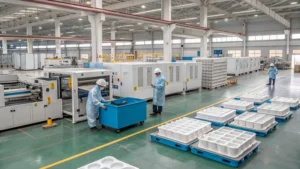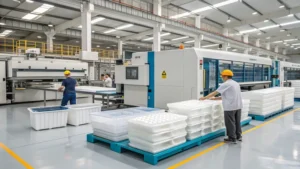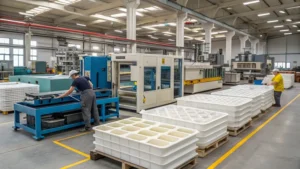
Vacuum forming is a versatile manufacturing process1 that heats a plastic sheet until pliable, then uses vacuum pressure to shape it over a mold, creating parts for industries like packaging and automotive.
Vacuum forming uses heat and vacuum pressure to shape plastic sheets2 over molds, producing cost-effective parts for packaging, automotive, and more, with material choice impacting success.
Selecting the right plastic is critical to achieving the desired performance and quality in formatura sottovuoto3. This blog post explores common plastics, key factors for selection, the process itself, comparisons to other methods, and practical tips to guide your decision.
ABS is the most commonly used plastic for vacuum forming.Vero
ABS is widely used due to its balance of strength, cost, and ease of forming.
La formatura sottovuoto è adatta solo per la produzione di bassi volumi.Falso
While often used for low to medium volumes, vacuum forming can also support higher volumes with the right setup and materials.
- 1. What are the Common Plastics Used in Vacuum Forming?
- 2. What are the Factors to Consider When Choosing a Plastic?
- 3. Quali sono le fasi del processo di formatura sottovuoto?
- 4. How Does Vacuum Forming Compare to Other Processes?
- 5. What are the Practical Tips for Selecting the Right Plastic?
- 6. Conclusione
What are the Common Plastics Used in Vacuum Forming?
The choice of plastic in vacuum forming affects the part’s strength, clarity, and cost, making material selection a key step in the process.
Comune vacuum forming plastics4 include ABS, HIPS, PETG, PVC, Acrylic, and Polycarbonate, each offering unique properties for applications like packaging, signage, and automotive parts.

Here’s a breakdown of the most popular plastics:
Acrilonitrile Butadiene Stirene (ABS)
ABS is strong, rigid, and impact-resistant, making it ideal for automotive parts, enclosures, and consumer goods. It’s easy to form and offers good dimensional stability.
Polistirene ad alto impatto (HIPS)
HIPS is cost-effective with decent impact strength and rigidity. It’s commonly used for packaging, signage, and disposable products but has lower temperature resistance.

Polietilene tereftalato glicole (PETG)
PETG is clear, FDA-approved, and recyclable, with good impact resistance. It’s used in food packaging, medical devices, and displays.
Cloruro di polivinile (PVC)
PVC is strong and chemically resistant, suitable for durable outdoor signage and construction materials. It can be trickier to form than other plastics.
Acrilico (PMMA)
Acrylic offers excellent clarity and weatherability, perfect for signage, displays, and lighting fixtures, though it’s brittle and less impact-resistant.

Policarbonato (PC)
Polycarbonate is highly durable and heat-resistant, used in safety shields and machine guards. It’s costly and challenging to form.
| Plastica | La forza | Clarity | Temperature Resistance | Costo | Applicazioni tipiche |
|---|---|---|---|---|---|
| ABS | Alto | Opaque | Medio | Medio | Parti automobilistiche, involucri |
| HIPS | Medio | Opaque | Basso | Basso | Imballaggio, segnaletica |
| PETG | Medio | Clear | Medio | Alto | Imballaggio alimentare, dispositivi medici |
| PVC | Alto | Opaque | Medio | Basso | Outdoor signage, construction |
| Acrylic | Medio | Clear | Medio | Alto | Signage, displays |
| Policarbonato | Molto alto | Clear | Alto | Alto | Safety shields, machine guards |
What are the Factors to Consider When Choosing a Plastic?
Selecting a plastic for vacuum forming requires balancing several factors to meet project needs.
Key factors in choosing a vacuum forming plastic include part requirements, volume di produzione5, budget, formability, and environmental considerations6.

-
Part Requirements: Assess strength, clarity, or temperature resistance needs.
-
Volume di produzione: Vacuum forming suits low to medium runs (250-3000 units/year).
-
Bilancio: Balance cost (e.g., low-cost HIPS vs. pricey polycarbonate) with performance.
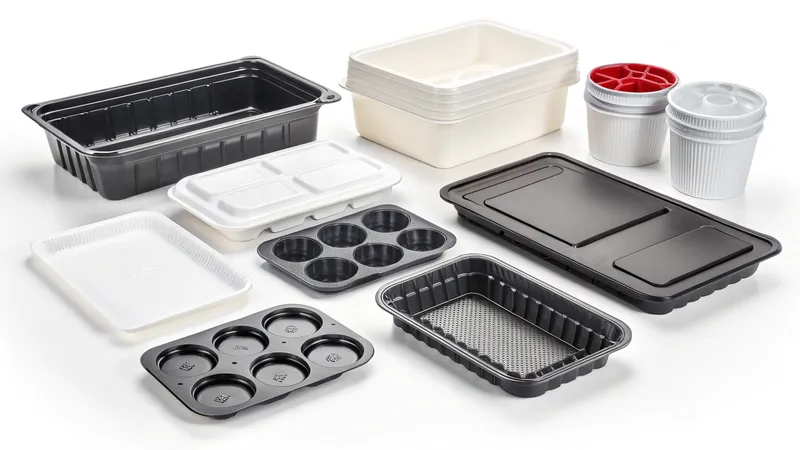
-
Formabilità: Easier plastics like ABS suit beginners; complex parts may need PETG.
-
Fattori ambientali: FDA-approved PETG works for food packaging.
Quali sono le fasi del processo di formatura sottovuoto?
Understanding the process highlights how plastic choice impacts results.
Vacuum forming heats a plastic sheet, stretches it over a mold, applies vacuum pressure, cools, and trims it, with plastic properties7 affecting each step.
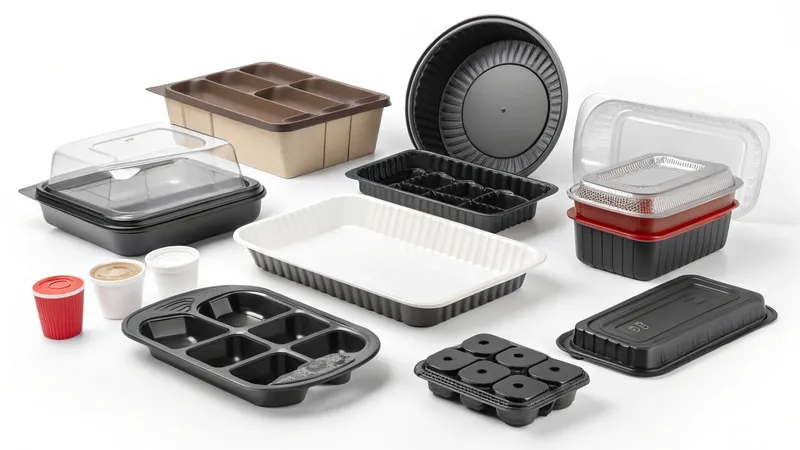
-
Riscaldamento: Plastic is heated to its temperatura di formatura8 (e.g., ABS: 140-190°C).
-
Stretching: The sheet is stretched over a mold (wood, aluminum, etc.).
-
Applicazione del vuoto: Vacuum pulls the plastic against the mold.
-
Raffreddamento: The part cools to set its shape, with timing varying by plastic.
-
Rifilatura: Excess material is removed, and finishing is applied.
Plastic properties like forming temperature and cooling rate influence outcomes.
How Does Vacuum Forming Compare to Other Processes?
Comparing vacuum forming to alternatives clarifies its advantages.
Vacuum forming excels in low to medium volumes and large parts compared to injection molding, which suits high volumes and complex shapes.

-
Vs. Stampaggio a iniezione: Vacuum forming is cheaper for low volumes; stampaggio a iniezione9 offers precision for high volumes.
-
Vs. Blow Molding: Vacuum forming suits solid parts; soffiatura10 is for hollow items.
What are the Practical Tips for Selecting the Right Plastic?
These tips streamline your decision-making process.
Choose a vacuum forming plastic by defining part needs, assessing volume, evaluating formability, considering environment, balancing cost, and testing options.

-
Define part requirements first.
-
Match plastic to production volume (e.g., HIPS for small runs).
-
Pick easy-to-form plastics if new to the process.
-
Consider environmental exposure (e.g., PVC for weather resistance).
-
Test plastics on a small scale if possible.
Explore resources like Toolcraft’s Material Guide.
Conclusione
Choosing the right plastic for vacuum forming is essential for quality results. By understanding plastics like ABS, HIPS, and PETG, evaluating key factors, and applying practical tips, you can optimize your project. Vacuum forming’s versatility shines with the right material choice.
-
Learn about the essential steps in the vacuum forming process to improve your understanding of this efficient manufacturing technique. ↩
-
Discover the best types of plastic sheets for vacuum forming to ensure quality and performance in your projects. ↩
-
Esplorate questo link per comprendere il processo di formatura sottovuoto e le sue applicazioni in vari settori, migliorando la vostra conoscenza delle tecniche di produzione. ↩
-
Explore this link to understand the various vacuum forming plastics and their specific applications, enhancing your material selection process. ↩
-
Exploring this topic can help you optimize material selection based on your production needs. ↩
-
This resource will provide insights into sustainable practices in plastic selection for vacuum forming. ↩
-
Understanding plastic properties is crucial for optimizing manufacturing; this resource will enhance your knowledge on the topic. ↩
-
Learn about forming temperature and its significance in plastic processing to improve your production techniques. ↩
-
Learn about the differences between injection molding and vacuum forming to make informed production choices. ↩
-
Discover the unique aspects of blow molding and its applications compared to vacuum forming. ↩



